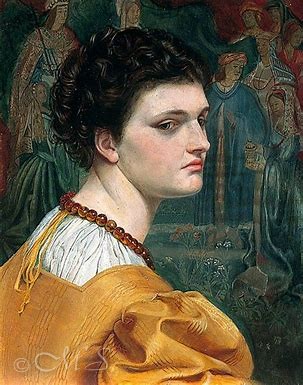Like Elisabetta Sirani, the first featured woman artist in this series, Emma Sandys had a tragically short life. When she died at age 34 of respiratory illness, her death was announced in a simple notice rather than true obituary or a celebration illustrating her artistic accomplishments.

Norwich, England was her birth city where she lived and worked the entirety of her life, 1843-1877. Little is known about her early life. It is likely she also came from modest means as her father was in the dyeing trade and her mother was a textile worker. Her brother, Frederick Sandys, was fourteen years older and learned to paint from their father as did Emma.
Sibling Rivalry in the 19th Century
Frederick was a member of the Pre-Raphaelites and of course competition between the siblings was unavoidable. Working in his shadow, Emma persevered and her reputation as a skilled artist grew. Doing mostly figurative compositions, her favorite subjects were depicted in domestic genre settings with vivid costumes and bright colorful hues. Her paintings were admired by patrons and collectors for their excellent execution and beauty.
A Brilliant and Masterful Use of Rich Color

Though there was competition between the siblings, Frederick had an enormous influence on his sister and she adapted his style and excelled at it. She later exhibited in many prestigious shows such as the Norwich and Eastern Counties Working Class Industrial Exhibition of 1867 and the Royal Academy the following year.
From my research, it is apparent that Emma, though comparatively as skilled as her brother and other Pre-Raphaelites, was never regarded in the same category as Frederick. Was this because of her early death?

Though she was prolific during the time she had as an artist, perhaps it was just not enough to make a huge impact. Or was she dismissed because she was a woman? In my opinion and my experience, I see many male artists’ works in history books and museums that are mediocre at best. Yet they are revered as masterful. We are still dancing backwards.
Dancing Backwards and in High Heels, a Pigment Project to be revealed May 2-4 at Bronze Coast Gallery, Cannon Beach, Oregon


Leave a Reply